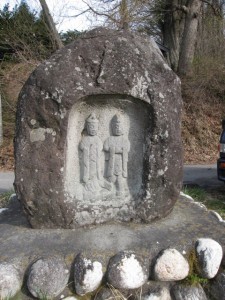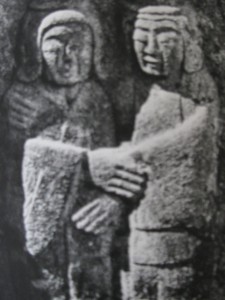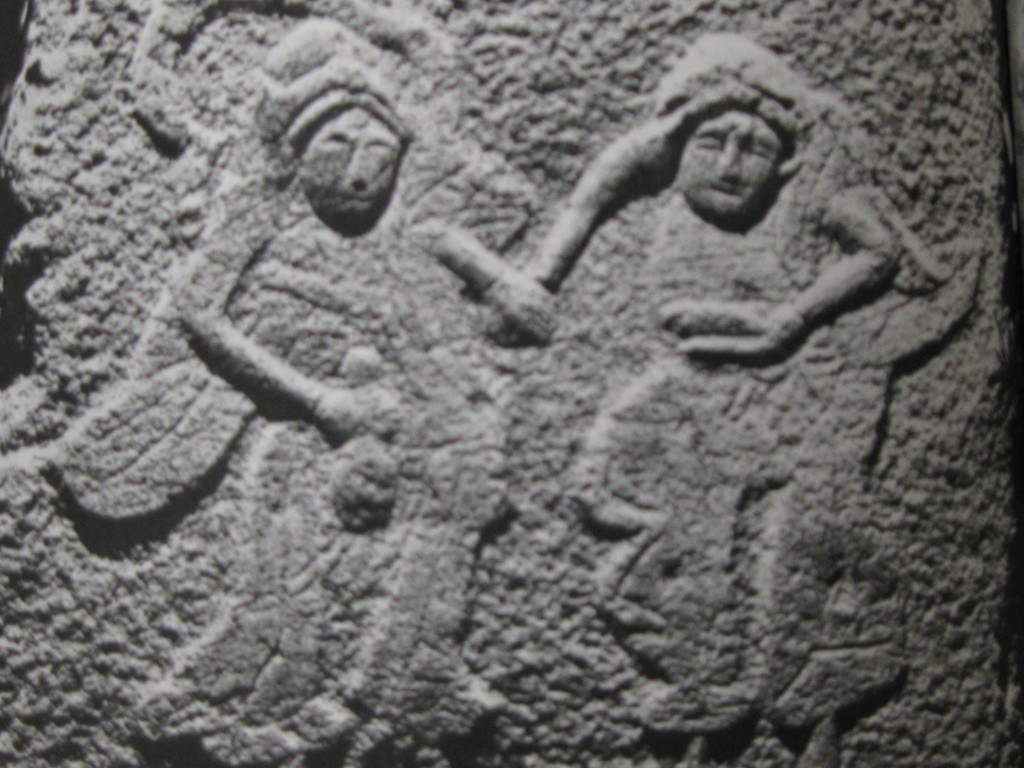
Example of a Dosojin couple on a stone marker
Green Shinto friend, Mark Schumacher, has produced an informative overview of Dosojin for his onmark website about Japanese Religions. Dosojin are protective markers that used to be placed at village boundaries, often with fertility symbols to encourage the growth of crops.
Mark’s page has sections on the Shinto tradition, the Buddhist tradition, and stone carvings, together with an annotated list of links to sites with dozens of photos. What follows below is the Shinto section of the webpage.
**************************************************
http://www.onmarkproductions.com/html/dosojin-stone-markers.shtml
The Shintō Tradition
Dōsojin refers to Shintō deities of roads and borders. Also called Dōrokujin 道陸神 and Sae no Kami or Sai no Kami 障の神・塞の神・道祖神 (with “sae / sai” meaning to obstruct or keep out the evil spirits). These deities reside in stone markers found at village boundaries, in mountain passes, and along country byways. In urban areas today, dōsojin stone markers are often placed at street corners and near bridges to protect pedestrians. As the deity of the village border, the dōsojin wards off evil spirits and catastrophes, and protects the village from evil outside influences. As deity of the road, the dōsojin protects travelers, pilgrims, and those in “transitional” stages. These stone markers may bear only inscriptions, but often they depict human forms, in particular the images of a man and woman — the latter manifestation is revered as the kami (deity) of marriage and fertility. In some localities, the dōsojin is worshiped as the kami of easy childbirth.

A Dosojin couple, with obvious fertility implications.
Says site contributor Dr. Gabi Greve: “The Takasago Legend 高砂伝説 is one of the oldest in Japanese mythology. An old couple — his name is Jō 尉 and her name is Uba 媼 — known together as Jō-to-Uba 尉と媼, are said to appear from the mist at Lake Takasago. The old man and his wife are usually portrayed talking happily together with a pine tree in the background. Signifying, as they do, a couple living in perfect harmony until they grow old together, they have long been a symbol of the happiness of family life. The story is portrayed in a famous Nō play called “Takasago no Uta.”
Japan’s popular Fire Festivals, held around January 15 each year, are known as dōsojin festivals. Shrine decorations, talismans, and other shrine ornaments used during the local New-Year holiday are gathered together and burned in bonfires. They are typically piled onto bamboo, tree branches, and straw, and set on fire to wish for good health and a rich harvest in the coming year.
The practice of burning shrine decorations has many names, including Sai-no-Kami Matsuri 道祖神祭, Sagichō 左義長, Seikisūhai 性器崇拝 and Dondo Yaki どんど焼. According to some, the crackling sound of the burning bamboo tells the listener whether the year will be lucky or not. Children throw their calligraphy into the bonfires — and if it flies high into the sky, it means they will become good at calligraphy.

Dosojin fertility couple from Nagano, where the stone markers can still be found by roadsides

Leave a Reply